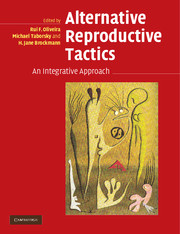Book contents
- Frontmatter
- Contents
- List of contributors
- Preface
- 1 The evolution of alternative reproductive tactics: concepts and questions
- PART I ULTIMATE CAUSES AND ORIGINS OF ALTERNATIVE REPRODUCTIVE TACTICS
- PART II PROXIMATE MECHANISMS OF ALTERNATIVE REPRODUCTIVE TACTICS
- PART III TAXONOMIC REVIEWS OF ALTERNATIVE REPRODUCTIVE TACTICS
- 8 Alternative reproductive tactics in insects
- 9 The expression of crustacean mating strategies
- 10 Alternative reproductive tactics in fish
- 11 Alternative reproductive tactics in amphibians
- 12 Alternative reproductive tactics in reptiles
- 13 Alternative reproductive tactics in birds
- 14 Alternative reproductive tactics in nonprimate male mammals
- 15 Alternative reproductive tactics in primates
- PART IV EMERGING PERSPECTIVES ON ALTERNATIVE REPRODUCTIVE TACTICS
- Index of species
- Subject index
- References
8 - Alternative reproductive tactics in insects
Published online by Cambridge University Press: 10 August 2009
- Frontmatter
- Contents
- List of contributors
- Preface
- 1 The evolution of alternative reproductive tactics: concepts and questions
- PART I ULTIMATE CAUSES AND ORIGINS OF ALTERNATIVE REPRODUCTIVE TACTICS
- PART II PROXIMATE MECHANISMS OF ALTERNATIVE REPRODUCTIVE TACTICS
- PART III TAXONOMIC REVIEWS OF ALTERNATIVE REPRODUCTIVE TACTICS
- 8 Alternative reproductive tactics in insects
- 9 The expression of crustacean mating strategies
- 10 Alternative reproductive tactics in fish
- 11 Alternative reproductive tactics in amphibians
- 12 Alternative reproductive tactics in reptiles
- 13 Alternative reproductive tactics in birds
- 14 Alternative reproductive tactics in nonprimate male mammals
- 15 Alternative reproductive tactics in primates
- PART IV EMERGING PERSPECTIVES ON ALTERNATIVE REPRODUCTIVE TACTICS
- Index of species
- Subject index
- References
Summary
CHAPTER SUMMARY
Discrete, alternative reproductive tactics (ARTs) occur in most orders of insects, across a wide array of mating systems, and during all steps in the reproductive process (locating a mate, gaining access to him/her, copulating, and post-copulatory behavior). ARTs for mate searching are particularly common and often involve a division between high-investment or high-risk but sedentary, nondispersing tactics and low-investment or low-risk but active, dispersing, searching tactics with longer-range movements. ARTs in insects are often associated with intense sexual selection and include individuals that avoid costly or high-risk intrasexual interactions, parasitizing the costly investment of others, or circumventing intersexual interactions and mate conflict. Two or more tactics can arise in a population when opportunities for success are discrete and require different and mutually exclusive behavior or morphology. Suites of distinctive, correlated traits arise through condition-dependent, developmental switches and when there is selection against individuals with intermediate traits (disruptive selection). ARTs are maintained in populations by frequency dependence and equality of fitness among tactics or as condition- or environment-dependent alternatives that maximize individual fitness.
THE PROBLEM
Discrete, alternative reproductive tactics (ARTs) within one sex and one population occur in most groups of insects (Table 8.1). For example, nonflying, large-headed, fighting males live in the nests of some female halictid (Kukuk and Schwarz 1988) and andrenid bees (Danforth 1991b) and mate with females inside the nest just prior to oviposition; while smaller, flying males with normal-looking heads and mandibles mate with females outside the nest as they forage on flowers (Danforth 1991b) (Figure 8.1).
- Type
- Chapter
- Information
- Alternative Reproductive TacticsAn Integrative Approach, pp. 177 - 223Publisher: Cambridge University PressPrint publication year: 2008
References
- 31
- Cited by



